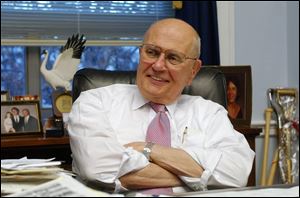
U.S. park status closer in Monroe
4/8/2006
Dingell
MONROE - After spending years in the hopeful stage, a national park in Monroe on the site of a famous War of 1812 battle moved a step closer to reality yesterday.
U.S. Rep. John Dingell (D., Dearborn) introduced legislation that supporters hope will create the River Raisinville National Battlefield Park.
"The River Raisin [battlefield site] has an important place in our state's and our nation's history," Mr. Dingell said. "We have a duty to protect it for our children so they can learn about the battles and appreciate those who died to protect the land."
In the winter of 1813, a battle between combined British and Native American troops and an outnumbered Kentucky militia resulted in the militia commander's surrendering his unit with the promise the soldiers would not be harmed. Several days later, more than 200 of the Kentuckians were killed by the Native Americans. Subsequently, "Remember the Raisin" became a rallying cry for American troops, who routed the British from lower Michigan a few months later.
The battle site eventually became home to several paper mills, and the property's significance largely was forgotten. With the demise of the mills, interest in the property as a historic site grew.
The Monroe County Historical Museum oversees a visitors' center with several exhibits that tell the story of the battle at the site, which is bordered by North Dixie Highway and East Elm Avenue. Several thousand people visit the center each year, according to museum director Ralph Naveaux.
"[If it becomes a national park], we would think it would become more of a magnet for visitors," Mr. Naveaux said.
That's what Monroe Mayor C.D. "Al" Cappuccilli is hoping. Mr. Cappuccilli, mayor for most of the last decade when the battlefield park issue became a hot topic, said he was overjoyed with the news about Mr. Dingell's proposed legislation.
"It's something we've been looking for for a long time," he said. "It means tourism. All of a sudden, with a national park here, people from all over the country will visit [Monroe]. This is a real coup for us."
Mr. Dingell cautioned that there's a lot of work to do before the park becomes a reality, including cleaning up the property and convincing the National Park Service that the site belongs in its system.
"Getting a bill like this through is like pushing a wheelbarrow uphill. It will take a lot of time. It will be a very hard task," he said.
The proposed legislation is in two parts. The first would authorize a study of the site to determine if a national park is feasible; the second would facilitate transfer of the land from the owners to the Interior Department to the National Park Service.
The site is about 38.5 acres, the majority of which is owned by the city and Roger Homrich, a Monroe businessman. Mr. Homrich is donating his land to the city, Mr. Naveaux said.
Mr. Dingell long has been a champion of historic preservation and environmental conservation projects. A River Raisin park, he said, fits with other projects in the region, such as the Detroit River International Wildlife Refuge he helped found.
"We're creating a situation where our people can know about our history. And we're working for a clean and wholesome environment. These are quality-of-life things," he said.
Contact George Tanber at:
gtanber@theblade.com
or 734-241-3610.